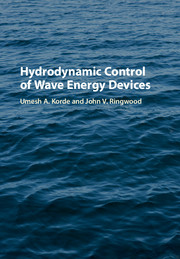Book contents
- Frontmatter
- Contents
- Preface
- Acknowledgments
- Part I Introduction
- Part II The Basics
- Part III The Hydrodynamics
- Part IV Velocity Control Using a Hydrodynamic Model
- Part V Control by Optimizing a Performance Index
- 9 Nonreactive Switching Control
- 10 Optimal Numerical Control of Wave Energy Converters
- 11 Control Strategies for WEC Arrays
- 12 Wave Forecasting for Control
- Part VI Toward Overall WEC System Hydrodynamic Optimization
- Part VII In Closing
- References
- Index
11 - Control Strategies for WEC Arrays
from Part V - Control by Optimizing a Performance Index
Published online by Cambridge University Press: 05 September 2016
- Frontmatter
- Contents
- Preface
- Acknowledgments
- Part I Introduction
- Part II The Basics
- Part III The Hydrodynamics
- Part IV Velocity Control Using a Hydrodynamic Model
- Part V Control by Optimizing a Performance Index
- 9 Nonreactive Switching Control
- 10 Optimal Numerical Control of Wave Energy Converters
- 11 Control Strategies for WEC Arrays
- 12 Wave Forecasting for Control
- Part VI Toward Overall WEC System Hydrodynamic Optimization
- Part VII In Closing
- References
- Index
Summary
Introduction
Just like wind farms, it is clear that commercial wave energy farms will contain multiple wave energy devices, relying on an economy of scale in reducing overall costs due to sea area leasing, moorings, electrical connections, and maintenance. However, while wind turbines interact only destructively in a collective (due to shadowing effects, etc.), wave energy devices in a farm have the possibility to interact constructively, since radiated waves from one device can reinforce the motion of another device.
However, the design of such a positively interacting collective depends on a number of factors, including the wave farm layout. In addition, the optimality of the layout (spacing, orientation, etc.), with respect to positive reinforcement, depends on sea state and incident wave direction, which, in general, are variable.
For a given wave farm layout, the geometry and motion of each device determines the radiated wave patterns, where the motion is strongly influenced by the control strategy employed on each device. This opens up the possibility that devices can, via inter device communication, coordinate their motion to the mutual benefit of all devices in the farm, with maximum farm power production as an objective. Such a structure, for a simple two-device array, is shown in Fig. 11.1.
Wave energy arrays include both large devices (circa 1 MW), individually moored, and closely packed arrays of devices, which are contained within a larger superstructure. Examples of larger individual devices include Pelamis [167], Oyster [168], and Powerbuoy [169], while closely spaced arrays include the Wavestar [45], Fred Olsen Lifesaver [170], and theManchester Bobber [171] devices, and the device developed by Trident Technologies [172]. In particular, compact circular arrays have been shown to be capable of extracting more energy than a single device of the same volume, and offer a larger spectral bandwidth [173].
Original work in the area of global control of arrays was carried out by Evans [30] and Falnes [174], who developed optimal control for a number of oscillating bodies. The focus was on extending complex-conjugate control to the multi-body case. Since then, however, little progress has been made on optimal array control, though a lot of research has focused on using differential (linear) damping on individual array elements. In particular, the benefits of optimal global array control over independent control are relatively unclear.
Information
- Type
- Chapter
- Information
- Hydrodynamic Control of Wave Energy Devices , pp. 239 - 256Publisher: Cambridge University PressPrint publication year: 2016
